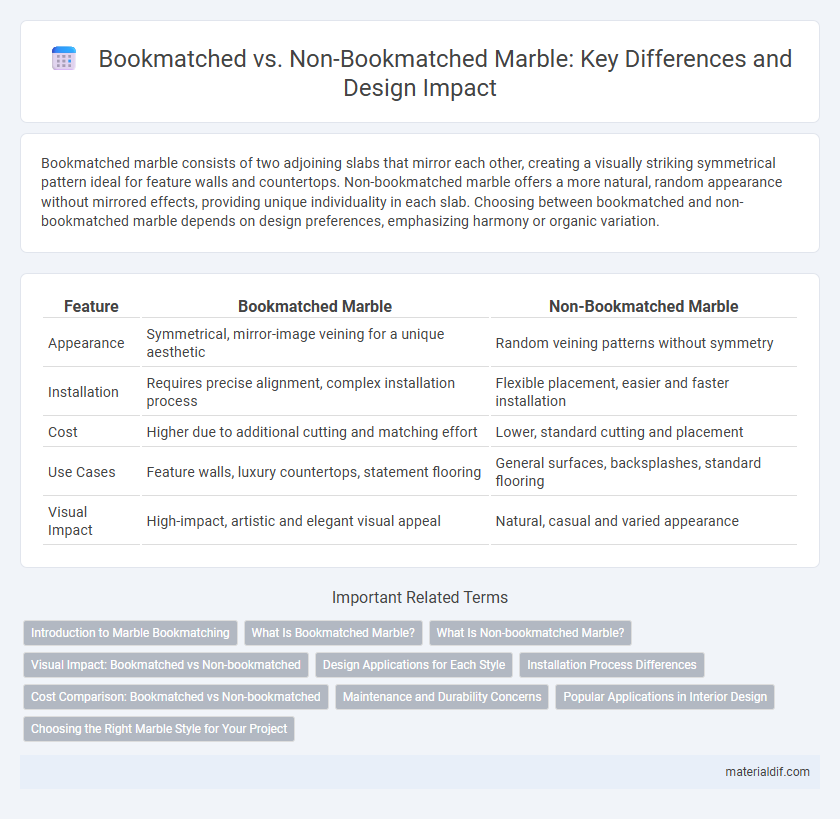Bookmatched marble consists of two adjoining slabs that mirror each other, creating a visually striking symmetrical pattern ideal for feature walls and countertops. Non-bookmatched marble offers a more natural, random appearance without mirrored effects, providing unique individuality in each slab. Choosing between bookmatched and non-bookmatched marble depends on design preferences, emphasizing harmony or organic variation.
Table of Comparison
| Feature | Bookmatched Marble | Non-Bookmatched Marble |
|---|---|---|
| Appearance | Symmetrical, mirror-image veining for a unique aesthetic | Random veining patterns without symmetry |
| Installation | Requires precise alignment, complex installation process | Flexible placement, easier and faster installation |
| Cost | Higher due to additional cutting and matching effort | Lower, standard cutting and placement |
| Use Cases | Feature walls, luxury countertops, statement flooring | General surfaces, backsplashes, standard flooring |
| Visual Impact | High-impact, artistic and elegant visual appeal | Natural, casual and varied appearance |
Introduction to Marble Bookmatching
Marble bookmatching involves pairing two slabs of marble so their patterns mirror each other, creating a symmetrical and visually striking effect often used in luxury interiors. This technique maximizes the natural veining and enhances the aesthetic appeal, distinguishing it from non-bookmatched marble where slabs are installed independently without mirrored patterns. Bookmatching is highly sought after in applications like countertops, wall cladding, and flooring for its unique design impact and artistic value.
What Is Bookmatched Marble?
Bookmatched marble consists of two slabs cut from the same block and polished to create symmetrical, mirror-image patterns, enhancing visual continuity in design projects. This technique accentuates the natural veining and texture unique to each marble variety, resulting in a striking, seamless aesthetic ideal for countertops, wall cladding, and flooring. Unlike non-bookmatched marble, where slabs are independently selected and installed, bookmatching maximizes the artistic impact by aligning patterns precisely.
What Is Non-bookmatched Marble?
Non-bookmatched marble refers to slabs that are cut and installed without matching the veining patterns across adjacent pieces, creating a more random and unique visual effect. Each slab in non-bookmatched marble displays distinct patterns, making it ideal for designs prioritizing natural variation rather than symmetry. This approach contrasts with bookmatched marble, where slabs are mirrored to create seamless, continuous veining.
Visual Impact: Bookmatched vs Non-bookmatched
Bookmatched marble creates a striking visual impact by mirroring patterns on adjacent slabs, producing symmetrical and dramatic designs that enhance aesthetic appeal. Non-bookmatched marble displays random, unique veining and patterns, offering a natural, organic look without symmetry. The choice influences the overall ambiance, with bookmatched surfaces appearing more formal and cohesive, while non-bookmatched provides a diverse and dynamic texture.
Design Applications for Each Style
Bookmatched marble features two slabs cut from the same block and mirrored side by side, creating symmetrical and visually striking patterns ideal for statement walls and upscale flooring applications. Non-bookmatched marble offers a more varied and natural appearance with unique, unpaired slabs suited for rustic or organic-designed spaces like kitchens and bathrooms where subtle elegance is preferred. Designers often select bookmatched marble to elevate sophistication in luxury interiors while non-bookmatched marble provides versatility and a more casual aesthetic.
Installation Process Differences
Bookmatched marble involves pairing two slabs with mirror-image patterns, requiring precise alignment during installation to maintain visual symmetry and seamless flow. The installation process for bookmatched marble demands skilled labor and additional time to match veins perfectly at the joints, increasing project complexity and cost. Non-bookmatched marble offers more straightforward installation as slabs are placed independently without the need for exact pattern alignment, reducing labor intensity and minimizing waste.
Cost Comparison: Bookmatched vs Non-bookmatched
Bookmatched marble typically incurs higher costs due to the precise cutting and matching process required to create symmetrical veining patterns, which demands skilled labor and results in increased material waste. Non-bookmatched marble is generally more affordable as it involves straightforward cutting without the necessity for pattern alignment, reducing fabrication time and material usage. The choice between bookmatched and non-bookmatched marble impacts overall project budgets, with bookmatched options suited for premium designs and non-bookmatched preferred for cost-effective applications.
Maintenance and Durability Concerns
Bookmatched marble features symmetrical veining patterns that create a visually striking effect but may require extra care to maintain its flawless appearance, as dirt and damage are more noticeable along matched seams. Non-bookmatched marble displays random veining, which can better conceal minor scratches and stains, reducing the frequency of maintenance. Durability is generally similar for both, but bookmatched slabs may demand more meticulous sealing to protect the delicate vein alignments from wear and environmental factors.
Popular Applications in Interior Design
Bookmatched marble panels create a symmetrical, mirror-image pattern, making them ideal for feature walls, fireplace surrounds, and luxury bathroom designs. Non-bookmatched marble offers unique, natural variations perfect for flooring, countertops, and backsplashes where a more organic and less uniform appearance is desired. Interior designers favor bookmatched marble in high-end residential and commercial spaces for dramatic visual impact, while non-bookmatched slabs provide versatility and ease of installation in everyday applications.
Choosing the Right Marble Style for Your Project
Bookmatched marble features mirrored slabs that create symmetrical patterns, enhancing visual impact and luxury in interior designs. Non-bookmatched marble offers more natural, varied veining, ideal for projects seeking a unique, organic look. Selecting between these styles depends on project aesthetics, budget, and desired pattern consistency for spaces like countertops, walls, or flooring.
Bookmatched vs Non-bookmatched Infographic

 materialdif.com
materialdif.com